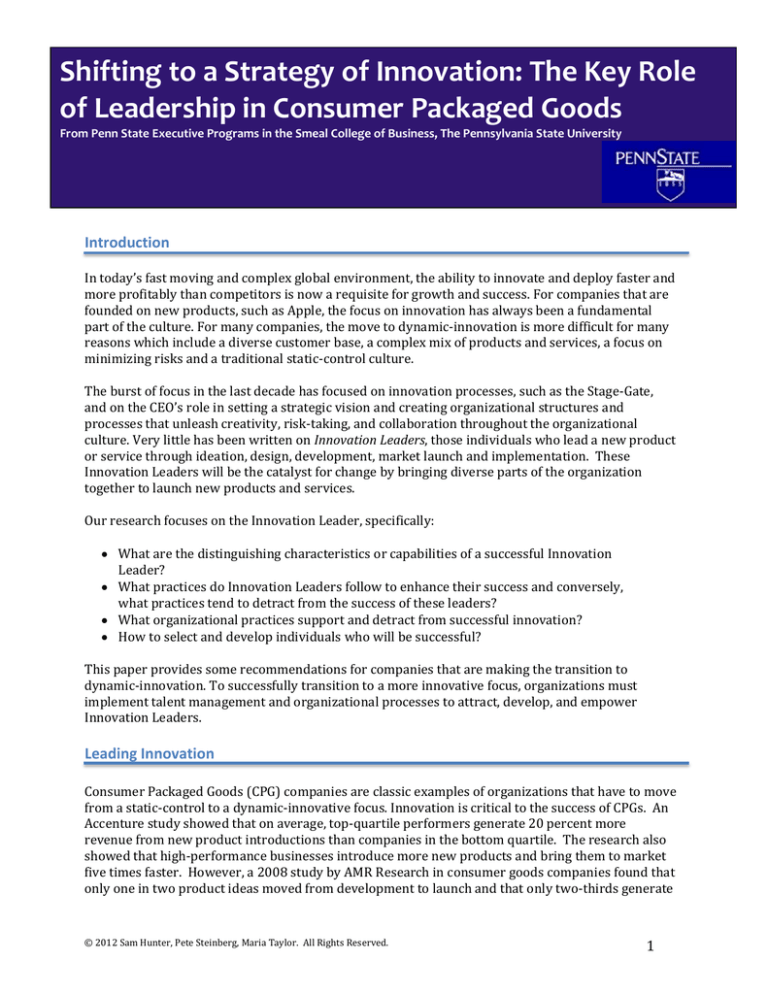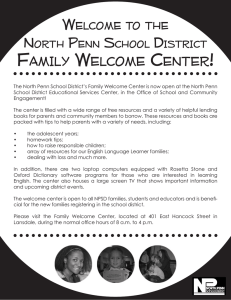
Shifting to a Strategy Innovation: The Key Role of Leadership in Consumer Packaged Goods
Penn State Executive Programs
Shifting to a Strategy of Innovation: The Key Role
of Leadership in Consumer Packaged Goods
From Penn State Executive Programs in the Smeal College of Business, The Pennsylvania State University
Introduction
In today’s fast moving and complex global environment, the ability to innovate and deploy faster and
more profitably than competitors is now a requisite for growth and success. For companies that are
founded on new products, such as Apple, the focus on innovation has always been a fundamental
part of the culture. For many companies, the move to dynamic-innovation is more difficult for many
reasons which include a diverse customer base, a complex mix of products and services, a focus on
minimizing risks and a traditional static-control culture.
The burst of focus in the last decade has focused on innovation processes, such as the Stage-Gate,
and on the CEO’s role in setting a strategic vision and creating organizational structures and
processes that unleash creativity, risk-taking, and collaboration throughout the organizational
culture. Very little has been written on Innovation Leaders, those individuals who lead a new product
or service through ideation, design, development, market launch and implementation. These
Innovation Leaders will be the catalyst for change by bringing diverse parts of the organization
together to launch new products and services.
Our research focuses on the Innovation Leader, specifically:
What are the distinguishing characteristics or capabilities of a successful Innovation
Leader?
What practices do Innovation Leaders follow to enhance their success and conversely,
what practices tend to detract from the success of these leaders?
What organizational practices support and detract from successful innovation?
How to select and develop individuals who will be successful?
This paper provides some recommendations for companies that are making the transition to
dynamic-innovation. To successfully transition to a more innovative focus, organizations must
implement talent management and organizational processes to attract, develop, and empower
Innovation Leaders.
Leading Innovation
Consumer Packaged Goods (CPG) companies are classic examples of organizations that have to move
from a static-control to a dynamic-innovative focus. Innovation is critical to the success of CPGs. An
Accenture study showed that on average, top-quartile performers generate 20 percent more
revenue from new product introductions than companies in the bottom quartile. The research also
showed that high-performance businesses introduce more new products and bring them to market
five times faster. However, a 2008 study by AMR Research in consumer goods companies found that
only one in two product ideas moved from development to launch and that only two-thirds generate
© 2012 Sam Hunter, Pete Steinberg, Maria Taylor. All Rights Reserved.
1
Shifting to a Strategy Innovation: The Key Role of Leadership in Consumer Packaged Goods
Penn State Executive Programs
the revenues expected. The study also found that over 50 percent of new products are brand
extensions rather than breakthrough products.
Innovation is a multi-disciplinary, cross-functional activity. In CPGs the innovation process needs to
touch all areas of the business including sales, operations, R&D, market research as well as retailers
and manufacturers. This network of resources places specific demands on the organization to find
people who can manage not only the process, but also the people involved.
Innovation Leader Capabilities
Our research included a survey of the literature and interviews with leaders inside CPG
organizations and innovation experts, consultant firms that specialize in helping companies create
innovative ideas, as well as leading academic faculty. In summary we found that successful
Innovation Leaders:
Take ownership to drive through the organization with passion and dedication for the product
and brand
Have the ability to alternate between the creative mind and the technical/operational/
business mind at different stages of the process
Are consumer-focused
Possess curiosity, intuition, and flexible problem-solving
Provide technical competency and functional expertise
Can effectively manage the creative process, collaborate, simplify, and inspire
Essentially, the Innovation Leader must think and act as both inspired, creative genius and the
strategic general manager. They must alternate among: 1) facilitating broad, creative thinking about
what is possible, 2) bringing disparate ideas and consumer insights together into revolutionary
product/service ideas, 3) analyzing the business risk, financial return, and operational implications
of taking the product to market, 4) motivating a cross-functional team to collaborate, and 5) building
support throughout the organization. Clearly, this role requires a resiliency to accept ambiguity and
to toy with, reframe, and abandon ideas.
These Innovation Leader capabilities have been validated and translated into assessment tools by
the Penn State Leadership and Innovation Laboratory. The three tools: Individual Creative Potential
Assessment, Leader Skill in Facilitating Innovation, and Team Climate Assessment for Innovation can
be used in recruiting, development, and performance management.
Innovation Leader Best and Worst Practices
Successful Innovation Leaders employ a common set of best practices that allow them to navigate
between generating creative, consumer-focused insights and making hard, analytical decisions about
feasibility and strategic fit. The best Innovation Leaders know how to work with the crossfunctional teams to allow the process to happen as broadly as possible, pulling ideas from outside,
protecting the “wild idea,” and creating a safe environment to make mistakes and have crazy ideas.
These leaders also know how to work with the innovation experts and other facilitators to spark
creativity while being intensely aware of how to get things done inside the organization.
© 2012 Sam Hunter, Pete Steinberg, Maria Taylor. All Rights Reserved.
2
Shifting to a Strategy Innovation: The Key Role of Leadership in Consumer Packaged Goods
Penn State Executive Programs
These best practices help to set project team expectations and provide a compass for each stage of
the product development process:
Best Practices
Ground idea in consumer needs
Align strategically and operationally
Use the Stage-Gate process
Build strong cross-functional team
Experiment and cut losses early
Work within needed timeframe and prices
Communication and project management
Plan for risks, disasters, and contingencies
Worst Practices
Take consumer input at face value
Lack of portfolio management
Change mind without rationale
Keep ideas secret
Get stuck in an idea
Lack insight into timing and price
Negativity
No post-mortem to learn from mistakes
The role of the Innovation Leader is very difficult as the path forward is never clear. These leaders
must keep a team motivated and moving forward despite a seemingly constant set of obstacles and
failures. Certain worst practices tend to derail the Innovation Leader’s success as well as sabotage
the project. With over 50 percent of ideas failing to pass through the Stage-Gate process and lead
times of 18 months or more from conception to launch, the Innovation Leader must have a strong
desire to succeed and a willingness to experiment. These leaders must also work to challenge the
operational status quo. The research is clear on what organizational practices support and detract
from successful innovation.
Driving Transformational Change
Our research finds that an organization’s ability to move from a static-control to a dynamicinnovative culture is enhanced by the combination of four elements:
Innovation Leaders possess a distinctive set of leadership capabilities
Rigorous deployment of a set of best practices
Strategic focus and organizational support for innovation
Organizational processes for innovation
Moreover, organizations that were successful in transforming: 1) had one or more executive
champions who actively challenged the status quo and first piloted projects through successful new
product launch and implementation, then 2) systemically inculcated each of the four elements.
We recommend an approach that combines the latest thinking in innovation leadership with
customization to the strategic context to drive change. This approach incorporates the following
steps:
1. Strategic Review: Base all initiatives in the strategic direction and goals of the organization
taking into consideration the competitive market environment and the business operations.
2. Talent and Performance Management Review: Understand the existing processes for
performance management, talent development, and competency models.
3. Innovation Leader Profile: Create a customized Innovation Leader Profile integrating the
strategic context with the Innovation Leadership Capabilities.
© 2012 Sam Hunter, Pete Steinberg, Maria Taylor. All Rights Reserved.
3
Shifting to a Strategy Innovation: The Key Role of Leadership in Consumer Packaged Goods
Penn State Executive Programs
4. Innovation Leadership Assessment: Assess the current pool of leaders in the Innovation
Leadership Dimensions of Creativity and Innovation Leadership. Identify the capability and
quantify the developmental requirements to meet strategic goals.
5. Creative Climate and Culture Assessment: Assess the current climate and culture for
creativity.
6. Develop the Innovation Talent Management Strategy: Develop an Integrated Talent
Management Strategy for innovation. The strategy should consider the development of
existing Innovation Leaders and key cross-functional team members as well as anticipating the
future capacity required to meet strategic goals. Elements of the plan include group and
individual development plans and a talent identification process including recruiting screens.
7. Develop the Innovation Scorecard: Finally, create a scorecard that links strategic goals to
innovation goals and to units and individual goals. The Innovation Scorecard balances current,
past, and future innovations along with the organization’s current performance review process.
This process encourages the Innovation Leadership development process to be linked and aligned
with organizational goals and reinforced through performance management. Without a similar
process it is possible that innovation leaders may be developed or the innovation strategy could be
successful in reaching its goals, but those leaders or the goals would not be supporting the
organizations long-term strategy.
About the Authors
Dr. Samuel Hunter is an Assistant Professor of Industrial and Organizational Psychology at Penn State
University, with expertise in both leadership and innovation management. He has partnered with a range of
organizations on applied and academic projects, including Lockheed Martin, Google, Nike, and Epic Games. His
research has been funded the National Science Foundation, Office of Naval Research, and the Department of
Defense. Dr. Hunter is the current director for the Leadership and Innovation Lab at Penn State University.
Pete Steinberg has been working with organizations for almost 15 years, helping clients create more effective
organizations. Pete provides consulting in strategic planning, marketing, innovation, and organizational
development. He is a master facilitator and instructor and works regularly as an executive coach for senior
executives. Pete is also an elite rugby coach, as the Head Coach of the 6-time National Champion Penn State
Women's Rugby team and the Head Coach of the USA Women's Rugby team.
Maria Taylor is the Managing Director of Penn State Executive Programs. She has worked with clients in
strategic and market planning, talent and learning systems solution design, and executive education. Maria coauthored Human Resource Transformation (Davies-Black 2008) and The Strategic Human Resource Leader:
How to Prepare Your Organization for the 6 Key Trends Shaping the Future (Davies-Black 1998).
Open the doors to transformational learning experiences with Penn State Executive Programs. We work
with organizations and leaders from around the world to help shape strategies and practices that fuel
competitive advantage and business success. We link strategic understanding with the development of new
capabilities in critical areas such as leadership, strategy, innovation, and supply chain management. Multipleday open programs are held throughout the year on Penn State’s University Park campus.
www.smeal.psu.edu/psep
© 2012 Sam Hunter, Pete Steinberg, Maria Taylor. All Rights Reserved.
4




